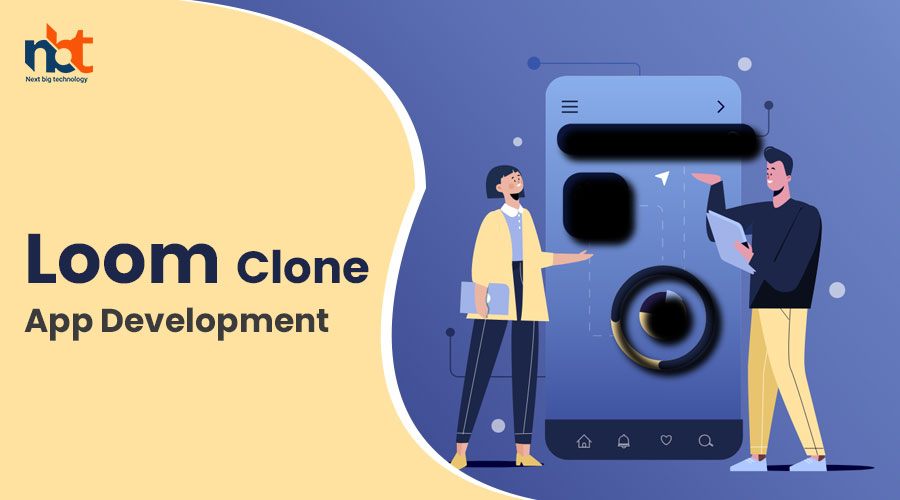Table of Contents
Loom Clone App Development Services
In today’s digital age, technology continues to reshape various industries, and the textile sector is no exception. The emergence of innovative solutions like Loom Clone App Development Services is revolutionizing the way textile businesses operate, enabling them to streamline processes, enhance productivity, and deliver superior customer experiences.
Loom Clone App Development Services offer a comprehensive suite of tools and features designed to replicate the functionalities of the popular Loom platform while allowing for customization to meet the specific needs of individual businesses. Whether you’re a textile manufacturer, retailer, or supplier, leveraging a Loom clone app can provide you with a competitive edge in the market.
One of the primary advantages of investing in Loom Clone App Development Services is the ability to digitize and automate various aspects of the textile production process. From order management and inventory tracking to production scheduling and quality control, these apps offer seamless integration and real-time visibility into every stage of the supply chain.
By centralizing data and streamlining workflows, Loom clone apps enable businesses to optimize resource utilization, reduce lead times, and minimize operational costs. This increased efficiency not only translates to higher profitability but also allows companies to meet growing customer demands with greater agility and responsiveness.
Moreover, Loom Clone App Development Services empower textile businesses to enhance collaboration and communication across their entire ecosystem. With features such as instant messaging, task assignment, and document sharing, stakeholders can coordinate efforts more effectively, resulting in smoother operations and faster decision-making.
Furthermore, these apps are equipped with advanced analytics capabilities that enable businesses to gain valuable insights into their performance metrics and market trends. By leveraging data-driven intelligence, companies can identify opportunities for optimization, anticipate customer preferences, and stay ahead of the competition.
From a customer perspective, Loom clone apps offer a seamless and intuitive shopping experience, allowing them to browse products, place orders, and track deliveries with ease. Personalization features enable businesses to tailor recommendations and promotions based on individual preferences, fostering customer loyalty and driving repeat purchases.
In addition to improving operational efficiency and enhancing customer satisfaction, investing in Loom Clone App Development Services can also future-proof your business against evolving market dynamics. With the flexibility to adapt to changing industry trends and consumer behaviors, these apps ensure that your business remains agile and resilient in the face of uncertainty.
How to Create a Loom Clone App Development
In today’s fast-paced digital landscape, video communication has become an integral part of our personal and professional lives. With the rising demand for seamless video conferencing tools, creating your own Loom clone app can be a lucrative venture. A Loom clone app allows users to record, share, and collaborate on videos effortlessly, enhancing productivity and communication across various domains. If you’re intrigued by the idea of developing your own Loom-like application, read on to discover the essential steps to bring your vision to life.
- Market Research and Analysis: Before diving into the development process, conduct thorough market research to understand the current landscape of video communication tools. Identify your target audience, analyze competitors, and pinpoint the unique features and functionalities that will set your Loom clone apart from existing solutions.
- Define Core Features: Outline the core features and functionalities that your Loom clone app will offer. These may include:
- Seamless video recording and screen capturing capabilities.
- Easy-to-use editing tools for trimming, cropping, and adding annotations.
- Cloud storage integration for storing and sharing videos securely.
- Real-time collaboration features, such as commenting and annotations.
- Customizable branding options for businesses and organizations.
- Analytics dashboard to track video engagement and performance metrics.
- Choose the Right Technology Stack: Selecting the appropriate technology stack is crucial for the success of your Loom clone app. Consider factors such as scalability, security, and compatibility across multiple platforms. Opt for reliable frameworks and programming languages suited to your project requirements, whether it’s native app development or cross-platform compatibility.
- UI/UX Design: Design an intuitive and user-friendly interface that prioritizes ease of navigation and accessibility. Focus on creating a seamless user experience with clean layouts, intuitive controls, and visually appealing aesthetics. Incorporate branding elements and customizable themes to enhance the app’s visual identity and appeal to diverse user preferences.
- Development and Testing: Collaborate with a skilled team of developers to bring your app concept to fruition. Follow agile development practices to iteratively build and refine your Loom clone app. Conduct rigorous testing across various devices and platforms to ensure functionality, performance, and security. Address any bugs or glitches promptly to deliver a polished and reliable user experience.
- Deployment and Launch: Prepare for the deployment and launch of your Loom clone app by setting up hosting infrastructure, configuring servers, and optimizing performance. Create compelling marketing materials and promotional campaigns to generate buzz and attract early adopters. Leverage social media, press releases, and app store optimization techniques to maximize visibility and drive downloads.
- Gather User Feedback and Iterate: Encourage user feedback and actively solicit suggestions for improvement from your app’s early adopters. Monitor user engagement metrics, gather insights from user reviews, and prioritize feature enhancements based on user preferences and pain points. Continuously iterate and evolve your Loom clone app to meet the evolving needs of your target audience.
Why Should You Go for Loom Clone App Development
In today’s fast-paced digital era, video communication has become an integral part of our personal and professional lives. With the rise of remote work and the need for seamless virtual collaboration, platforms like Loom have gained immense popularity. However, creating a Loom clone app tailored to specific needs can offer numerous advantages. Let’s delve into why opting for Loom clone app development might be the perfect choice for your business or project.
- Customization and Branding: One of the primary benefits of developing a Loom clone app is the ability to customize it according to your brand’s identity and specific requirements. By incorporating your branding elements such as logo, color scheme, and messaging, you can create a unique and cohesive user experience that resonates with your target audience. This level of customization fosters brand recognition and trust among users.
- Enhanced Features and Functionality: While Loom offers a robust set of features for video recording and sharing, developing a clone app allows you to enhance functionality based on your users’ needs. Whether it’s integrating advanced editing tools, adding interactive elements, or implementing analytics for performance tracking, customization empowers you to deliver a superior user experience. By staying ahead of the curve with innovative features, you can outshine competitors and attract a loyal user base.
- Scalability and Flexibility: Another advantage of opting for Loom clone app development is scalability. As your business grows and evolves, your video communication needs may change. With a custom-built app, you have the flexibility to scale up or down seamlessly, adapting to changing demands and user feedback. Whether you’re a small startup or a large enterprise, scalability ensures that your video communication platform can accommodate increasing user volumes without compromising performance or user experience.
- Data Security and Compliance: Data security and privacy are paramount concerns in today’s digital landscape. By developing a Loom clone app, you gain greater control over data security measures and compliance standards. You can implement robust encryption protocols, access controls, and compliance features to safeguard sensitive information and ensure regulatory compliance. This not only protects your users’ data but also enhances trust and credibility in your platform.
- Cost-effectiveness: While Loom and similar platforms offer subscription-based pricing models, developing a custom clone app can provide long-term cost savings. By investing upfront in app development, you avoid ongoing subscription fees and have full ownership and control over your platform. Additionally, you can optimize costs by selecting features and functionalities that align with your budget and priorities, avoiding unnecessary expenses associated with off-the-shelf solutions.
Market Prospects of Loom Clone App Development and Platforms
In recent years, the technological landscape has witnessed a surge in the popularity of social media platforms and communication tools. Among these, video conferencing applications have experienced unprecedented growth, especially in the wake of the global pandemic. One such notable player in the market is Loom, a versatile video messaging tool that has gained traction among professionals and businesses alike. As the demand for remote collaboration continues to soar, the market prospects for Loom clone app development and platforms are promising and worth exploring.
Understanding the Loom Phenomenon
Loom has carved a niche for itself by offering a seamless video communication experience that transcends geographical barriers. Its intuitive interface, coupled with robust features such as screen recording, allows users to create and share video messages effortlessly. From remote team meetings to client presentations, Loom has become an indispensable tool for individuals and organizations seeking efficient communication solutions.
Market Dynamics
The market dynamics surrounding Loom clone app development are shaped by several factors:
- Remote Work Culture: The proliferation of remote work culture has fueled the demand for virtual communication tools. As companies embrace flexible work arrangements, the need for reliable video conferencing solutions like Loom clones is on the rise.
- Entrepreneurial Opportunities: The success of Loom has inspired entrepreneurs and developers to explore similar app concepts. By offering customizable features and tailored solutions, Loom clone app development presents lucrative entrepreneurial opportunities in the burgeoning tech industry.
- Vertical Integration: With the integration of advanced functionalities such as real-time collaboration and augmented reality (AR) features, Loom clone platforms have the potential to cater to diverse industry verticals beyond traditional business communication.
Key Market Trends
Several trends are shaping the market prospects of Loom clone app development and platforms:
- Personalized User Experience: Users increasingly demand personalized experiences tailored to their specific needs. Loom clone developers are focusing on enhancing user engagement through customizable features and intuitive interfaces.
- Integration with Productivity Tools: Seamless integration with popular productivity tools such as Slack, Trello, and Google Workspace enhances the utility of Loom clone platforms, making them indispensable for workflow optimization.
- Security and Privacy Features: With growing concerns over data privacy and security, Loom clone developers are prioritizing robust encryption protocols and compliance with data protection regulations to instill trust among users.
Opportunities and Challenges
While the market prospects for Loom clone app development are promising, developers and entrepreneurs need to navigate certain challenges:
- Competition: The video conferencing market is highly competitive, with established players like Zoom, Microsoft Teams, and Google Meet dominating the landscape. To succeed, Loom clone platforms must differentiate themselves through innovation and value-added features.
- Technical Complexity: Building a robust and scalable Loom clone app entails overcoming technical complexities such as server infrastructure management, video encoding, and optimization for multiple devices and operating systems.
- Market Saturation: The proliferation of Loom clone apps and platforms may lead to market saturation, making it imperative for developers to identify niche markets and target specific user segments effectively.
Essential Features of a Loom Clone App Development
In recent years, the demand for video conferencing applications has skyrocketed, and with it, the need for innovative solutions tailored to specific niches. Among these, Loom Clone App Development has emerged as a promising avenue, offering users a unique blend of functionality and convenience. However, to create a successful Loom clone app, developers must integrate essential features that meet the evolving needs of users. Let’s delve into the crucial elements that make a Loom clone app stand out in today’s competitive market.
- User-Friendly Interface: The hallmark of any successful application is its user interface. A Loom clone app should boast an intuitive design that allows users to navigate effortlessly. From recording video messages to sharing them seamlessly, every action should be streamlined for maximum convenience.
- Recording and Editing Tools: Central to the functionality of a Loom clone app are its recording and editing capabilities. Users should have access to a range of tools that enable them to create professional-quality videos with ease. Features like screen recording, webcam integration, and basic editing functionalities such as trimming and merging are essential for enhancing the user experience.
- Customization Options: Every user has unique preferences and requirements when it comes to video communication. A robust Loom clone app should offer extensive customization options, allowing users to personalize their recordings with custom backgrounds, logos, and branding elements. This not only enhances the professional appeal of the videos but also fosters brand consistency.
- Integration with Collaboration Tools: In today’s digital landscape, seamless collaboration is paramount. A Loom clone app should integrate seamlessly with popular collaboration tools such as Slack, Trello, and Google Workspace. This allows users to share their video messages effortlessly within their existing workflows, enhancing productivity and efficiency.
- Security Features: Privacy and data security are non-negotiable in any communication platform. A Loom clone app should prioritize the implementation of robust security measures, including end-to-end encryption, multi-factor authentication, and secure data storage practices. This instills confidence in users and ensures that their sensitive information remains protected at all times.
- Cross-Platform Compatibility: To cater to a diverse user base, a Loom clone app should be compatible with a wide range of devices and operating systems. Whether accessing the app from a desktop computer, tablet, or smartphone, users should enjoy a seamless experience across all platforms. This not only expands the app’s reach but also enhances its accessibility.
- Real-Time Collaboration Features: In addition to asynchronous communication, a Loom clone app should also facilitate real-time collaboration. Features such as live streaming, interactive Q&A sessions, and real-time chat functionality enable users to engage with their audience in dynamic ways, fostering meaningful interactions and driving engagement.
- Analytics and Insights: To empower users with actionable data, a Loom clone app should incorporate robust analytics and insights tools. From tracking viewer engagement to monitoring video performance, these features provide valuable feedback that users can leverage to refine their content and optimize their communication strategies.
Advanced Features of a Loom Clone App Development
In the contemporary digital era, the significance of video communication has surged, with platforms like Loom gaining immense popularity. Loom, with its seamless interface and intuitive features, has become a preferred choice for businesses and individuals alike. The demand for Loom-like applications has led to the emergence of Loom clone app development, offering advanced features that enhance user experience and productivity.
Let’s delve into the advanced features that make a Loom clone app development stand out:
- Customization Options: One of the key features of a Loom clone app is its ability to offer extensive customization options. Users can personalize their videos by adding branding elements such as logos, colors, and intro/outro segments, aligning them with their brand identity.
- Multi-platform Compatibility: To cater to diverse user preferences, a Loom clone app is designed to be compatible with multiple platforms, including web, mobile, and desktop. This ensures seamless access across devices, allowing users to record and share videos conveniently.
- Enhanced Security Measures: Recognizing the importance of data security and privacy, advanced Loom clone apps incorporate robust security measures. End-to-end encryption, secure authentication protocols, and data access controls ensure that sensitive information remains protected.
- Real-time Collaboration: Facilitating teamwork and collaboration, Loom clone apps offer real-time co-editing features. Users can invite team members to collaborate on video projects, providing feedback, making annotations, and editing content collaboratively.
- Integration Capabilities: Integration with third-party tools and applications is another hallmark of advanced Loom clone apps. Seamless integration with project management tools, CRMs, and communication platforms enhances workflow efficiency and productivity.
- Analytics and Insights: To enable users to gauge the effectiveness of their video content, advanced Loom clone apps provide comprehensive analytics and insights. Users can track metrics such as viewer engagement, retention rates, and conversion rates, empowering them to refine their video strategies.
- Advanced Editing Tools: Empowering users to create professional-quality videos, Loom clone apps offer a range of advanced editing tools. From trimming and cropping to adding annotations and captions, users can enhance their videos with ease.
- Automated Workflows: Streamlining the video creation process, Loom clone apps leverage automation to simplify repetitive tasks. Features such as automated transcription, captioning, and thumbnail generation save time and effort, allowing users to focus on creating compelling content.
- AI-Powered Features: Leveraging the capabilities of artificial intelligence (AI), advanced Loom clone apps offer AI-powered features such as speech-to-text conversion, sentiment analysis, and facial recognition. These features enhance accessibility, personalization, and user engagement.
- Scalability and Performance: With a focus on scalability and performance, Loom clone apps are designed to handle large volumes of video content seamlessly. Cloud-based infrastructure, scalable architecture, and optimized performance ensure smooth operation even under high load conditions.
Loom Clone App Development Timelines
In today’s fast-paced digital world, video communication has become an integral part of our lives, especially in the workplace. Platforms like Loom have revolutionized how teams collaborate remotely by allowing users to record and share quick videos effortlessly. If you’re considering developing a Loom clone app, understanding the timelines involved is crucial for planning and execution. Let’s delve into the development process and explore the timelines associated with creating your own Loom-inspired application.
- Conceptualization Phase (2-4 Weeks): This initial phase involves brainstorming ideas, identifying key features, and defining the scope of your Loom clone app. Engage with stakeholders, conduct market research, and gather insights to validate your concept. Consider aspects like video recording, editing tools, sharing options, and user interface design. By the end of this phase, you should have a clear understanding of what your app will offer and its target audience.
- UI/UX Design (4-6 Weeks): User experience (UX) and user interface (UI) design are paramount in ensuring your app is intuitive and visually appealing. Work closely with designers to create wireframes, mockups, and prototypes. Focus on simplicity, ease of navigation, and consistency throughout the app. Iterative feedback loops are essential during this phase to refine and improve the design based on user testing and feedback.
- Backend Development (6-8 Weeks): The backend development phase involves building the server, database, and APIs that will power your Loom clone app. Choose the appropriate technology stack based on scalability, security, and performance requirements. Implement features like user authentication, video storage, and data encryption to ensure a seamless experience for your users. Collaboration between backend developers and frontend teams is essential to integrate functionalities seamlessly.
- Frontend Development (8-10 Weeks): Frontend development focuses on translating the UI/UX designs into functional interfaces that users interact with. Develop responsive layouts, interactive elements, and integrate multimedia features for recording and editing videos. Pay attention to performance optimization and cross-platform compatibility to cater to a diverse user base. Continuous testing and debugging are crucial to identify and fix any issues promptly.
- Testing and Quality Assurance (4-6 Weeks): Testing is a critical phase to ensure your Loom clone app functions flawlessly across different devices and operating systems. Conduct thorough testing including functional testing, usability testing, performance testing, and security testing. Address any bugs, glitches, or compatibility issues discovered during testing promptly to deliver a polished product to your users.
- Deployment and Launch (2-4 Weeks): Once testing is complete and any necessary refinements have been made, it’s time to prepare for deployment. Deploy your app to app stores like Google Play Store and Apple App Store following their guidelines and submission processes. Plan a strategic marketing campaign to generate buzz and attract users to download and try your app. Monitor user feedback and analytics closely post-launch to gather insights for further enhancements.
- Post-launch Support and Updates (Ongoing): Launching your Loom clone app is just the beginning of your journey. Provide ongoing support to address user inquiries, feedback, and technical issues promptly. Regularly release updates with new features, performance improvements, and bug fixes to keep your app relevant and competitive in the market. Engage with your user community through social media, forums, and newsletters to foster loyalty and drive user retention.
How Much Does It Cost to Build a Loom Clone App Development?
In the fast-paced world of technology, the demand for innovative solutions in the realm of communication and collaboration has skyrocketed. One such solution that has gained significant traction is Loom, a video messaging platform that enables users to record, share, and discuss videos seamlessly. With its user-friendly interface and powerful features, Loom has become a go-to tool for remote teams, educators, and content creators alike.
As businesses and entrepreneurs look to capitalize on the success of Loom, many are considering developing their own Loom clone app. However, one of the burning questions that often arises is, “How much does it cost to build a Loom clone app?”
The cost of developing a Loom clone app can vary significantly depending on various factors such as features, complexity, platform, and development team. Here’s a breakdown of the key factors that influence the cost:
- Feature Set: The cost of developing a Loom clone app largely depends on the features and functionalities you want to incorporate. Basic features such as video recording, editing, and sharing will be less costly compared to advanced features like real-time collaboration, analytics, and integrations with other platforms.
- Platform: Another factor that influences the cost is the choice of platform(s) for which the app will be developed. Developing a Loom clone app for a single platform (either iOS or Android) will generally cost less compared to building a cross-platform app that works seamlessly across multiple devices and operating systems.
- Design: The design and user interface of the app also play a significant role in determining the cost. A well-designed and intuitive interface will require more time and resources from UI/UX designers, leading to higher development costs.
- Development Team: The cost of hiring developers and engineers for your Loom clone app project can vary depending on their expertise and location. Hiring a reputable development team with experience in building video messaging apps may cost more upfront but can save you time and money in the long run by ensuring a high-quality end product.
- Maintenance and Support: It’s essential to factor in the cost of ongoing maintenance and support for your Loom clone app. Regular updates, bug fixes, and customer support are crucial for ensuring the app’s smooth functioning and user satisfaction.
While it’s challenging to provide an exact figure for the cost of developing a Loom clone app without knowing specific requirements, a rough estimate could range anywhere from $20,000 to $100,000 or more, depending on the complexity and scale of the project.
How to Create a Loom Clone App Development – Team and Tech Stack
In today’s digital era, video communication has become an integral part of our lives, especially with the rise of remote work and virtual interactions. Platforms like Loom have revolutionized how we share information through quick video recordings. If you’re considering developing your own Loom clone app, you’re stepping into a promising niche. However, embarking on this journey requires careful planning, the right team, and a robust tech stack. Let’s delve into the essentials of creating your Loom clone app.
Understanding the Concept
Before diving into development, it’s crucial to grasp the essence of Loom and its features. Loom allows users to capture their screen, record their webcam, and narrate their actions, making it a powerful tool for tutorials, presentations, and communication. Analyze Loom’s functionalities, user experience, and target audience to identify what makes it successful and how you can differentiate your clone app.
Building Your Team
- Developers: You need skilled developers proficient in web or mobile app development, depending on your platform choice. Front-end developers handle the user interface, while back-end developers manage server-side operations and databases. Full-stack developers can bridge both ends, ensuring seamless integration.
- UI/UX Designers: A captivating user interface and intuitive user experience are paramount for your app’s success. UI/UX designers will craft visually appealing layouts and ensure smooth navigation, enhancing user engagement.
- Quality Assurance (QA) Team: Thorough testing is essential to identify and rectify any bugs or glitches. QA testers meticulously evaluate the app’s functionality, performance, and security across various devices and scenarios.
- Project Manager: A project manager oversees the development process, ensuring timely delivery, effective communication among team members, and alignment with the project goals and specifications.
Choosing the Right Tech Stack
- Front-end Development: For web applications, consider frameworks like React.js or Angular.js for dynamic user interfaces. For mobile apps, options include React Native for cross-platform development or native languages like Swift for iOS and Kotlin for Android.
- Back-end Development: Node.js is a popular choice for building scalable and efficient server-side applications due to its event-driven architecture and extensive library ecosystem. Alternatively, you can opt for other frameworks like Django (Python) or Express.js (Node.js) based on your team’s expertise and project requirements.
- Database Management: Choose a database system that aligns with your app’s scalability and data structure needs. Options range from relational databases like MySQL and PostgreSQL to NoSQL databases like MongoDB for flexible data storage.
- Cloud Services: Leverage cloud platforms such as AWS, Google Cloud Platform, or Microsoft Azure for hosting, storage, and scalability. These services offer reliable infrastructure, security features, and scalability, crucial for a robust app architecture.
Emphasizing Security and Scalability
Security should be a top priority throughout the development process. Implement encryption protocols, authentication mechanisms, and data validation techniques to safeguard user data and privacy. Additionally, design your app with scalability in mind to accommodate growing user bases and evolving requirements seamlessly.
Loom Clone App Development Process
In the dynamic world of social media and communication, video-sharing platforms have surged in popularity, with Loom being one of the pioneers in the field. Its seamless interface and efficient screen recording features have garnered a massive user base. If you’re considering diving into the realm of video-sharing apps and are intrigued by the idea of developing a Loom clone app, you’re in the right place. In this guide, we’ll walk you through the comprehensive process of developing your own Loom clone app.
Understanding the Concept
Before delving into the development process, it’s essential to grasp the fundamental concept of Loom. At its core, Loom is a screen and video recording tool that allows users to capture their screens, webcam, and microphone simultaneously, making it perfect for creating tutorials, presentations, and product demos. Your Loom clone should aim to replicate these functionalities while adding your unique touch to differentiate it in the market.
Market Research
Market research forms the foundation of any successful app development project. Analyze the existing video-sharing platforms, including their features, user interface, target audience, and monetization strategies. Identify the gaps and opportunities that your Loom clone can capitalize on. Understanding user preferences and industry trends will guide your development process and help you create a competitive and appealing product.
Defining Features and Functionalities
Based on your market research, outline the features and functionalities that your Loom clone app will offer. Key features may include:
- Screen Recording: Enable users to capture their screens with options for full-screen recording or selective area recording.
- Webcam Recording: Allow users to include webcam footage alongside screen recording for personalized videos.
- Audio Recording: Integrate audio recording capabilities, enabling users to narrate their videos or add background music.
- Editing Tools: Provide basic editing tools such as trimming, cropping, and adding annotations to enhance the recorded videos.
- Cloud Storage: Offer seamless cloud storage integration for easy access and sharing of recorded videos across devices.
- Privacy Settings: Implement privacy settings to control the visibility of videos and ensure user data protection.
- Customization Options: Allow users to customize recording settings, including video quality, frame rate, and audio input.
Choosing the Right Technology Stack
Selecting the appropriate technology stack is crucial for the successful development of your Loom clone app. Consider factors such as scalability, platform compatibility, and development resources. Popular technologies for building video-sharing apps include:
- Frontend: React Native, Flutter
- Backend: Node.js, Django
- Database: MongoDB, PostgreSQL
- Cloud Storage: Amazon S3, Google Cloud Storage
Choose a combination of technologies that align with your project requirements and development expertise.
Development Process
The development process typically follows these stages:
- UI/UX Design: Create intuitive and visually appealing designs that prioritize user experience.
- Frontend Development: Develop the client-side application using chosen frameworks and libraries.
- Backend Development: Build the server-side logic, database management, and API integration.
- Integration and Testing: Integrate frontend and backend components and conduct rigorous testing to ensure functionality and performance.
- Deployment: Deploy the app on app stores and cloud platforms, ensuring seamless accessibility for users.
- Maintenance and Updates: Continuously monitor and maintain the app, addressing user feedback and rolling out updates to enhance features and security.
Monetization Strategies
Finally, consider monetization strategies to generate revenue from your Loom clone app. Options include:
- Subscription Plans: Offer tiered subscription plans with varying features and benefits.
- In-App Advertisements: Display targeted advertisements within the app to generate ad revenue.
- Premium Features: Introduce premium features or content available for purchase within the app.
- Freemium Model: Provide basic features for free with the option to upgrade to a premium version for enhanced functionality.
Next Big Technology – Your Trusted Loom Clone App Development Partner
In the dynamic landscape of technology, innovation is the cornerstone of progress. As we move forward into the next era of digital transformation, the demand for groundbreaking solutions continues to soar. Among the array of emerging technologies, the rise of blockchain-based platforms has been nothing short of remarkable. One such revolutionary concept that has garnered significant attention is the Loom Clone App – a powerful tool with the potential to redefine various industries.
In essence, a Loom Clone App is a decentralized application (DApp) built on the Loom Network, a high-performance blockchain platform. It enables developers to create scalable, secure, and user-friendly applications with robust functionalities. From gaming and finance to supply chain management and social networking, the applications of Loom Clone technology are virtually limitless.
In today’s hyper-competitive market, finding a trusted partner for Loom Clone app development is paramount. With the exponential growth of blockchain-based solutions, businesses need a reliable ally who can navigate the complexities of this rapidly evolving ecosystem. This is where your trusted Loom Clone app development partner steps in to pave the way for your success.
Why Choose Us as Your Loom Clone App Development Partner?
- Expertise and Experience: With years of hands-on experience in blockchain technology and app development, we possess the knowledge and skills required to bring your vision to life. Our team of seasoned professionals stays abreast of the latest trends and innovations in the blockchain space, ensuring that your Loom Clone app remains at the forefront of technological advancement.
- Tailored Solutions: We understand that every project is unique, with its own set of challenges and requirements. That’s why we take a personalized approach to app development, working closely with you to tailor solutions that align with your specific goals and objectives. Whether you’re looking to create a gaming platform, a decentralized marketplace, or a financial application, we have the expertise to turn your ideas into reality.
- Scalability and Performance: One of the key advantages of the Loom Network is its scalability and high throughput. By leveraging this cutting-edge technology, we ensure that your Loom Clone app can handle a large volume of transactions with minimal latency, providing users with a seamless and responsive experience. Whether you’re targeting a niche market or a global audience, scalability is never a concern with our Loom Clone solutions.
- Security and Reliability: Security is paramount in the world of blockchain, where trust is built on immutable ledgers and cryptographic protocols. We employ best-in-class security measures to safeguard your Loom Clone app against potential threats and vulnerabilities, ensuring that your users can transact with confidence. With our robust security framework, you can rest assured that your app is protected against unauthorized access and malicious attacks.
- Ongoing Support and Maintenance: Our commitment to your success doesn’t end with the launch of your Loom Clone app. We provide comprehensive support and maintenance services to ensure that your app remains up and running smoothly at all times. From bug fixes and software updates to performance optimizations and feature enhancements, we’re here to support you every step of the way.
Enterprise Loom Clone App Development
In today’s fast-paced business landscape, effective communication and collaboration are key drivers of success for enterprises worldwide. With the rise of remote work and distributed teams, organizations are constantly seeking innovative solutions to streamline their workflow and enhance productivity. One such solution that has gained significant traction is Enterprise Loom Clone App Development.
Loom, a popular video messaging platform, has revolutionized the way teams communicate and collaborate. Its intuitive interface and robust features empower users to create and share video messages effortlessly, enabling seamless knowledge sharing and decision-making.
Enterprise Loom Clone App Development takes this concept a step further by customizing the platform to meet the specific needs of large organizations. Whether it’s integrating with existing enterprise systems, implementing advanced security measures, or scaling to accommodate thousands of users, a customized Loom clone app can provide a tailored solution that aligns with the organization’s goals and objectives.
Here are some key features and benefits of Enterprise Loom Clone App Development:
- Seamless Integration: The clone app can be seamlessly integrated with existing enterprise tools and systems, such as project management software, CRM platforms, and internal communication channels, ensuring a smooth transition and minimal disruption to workflow.
- Advanced Security: With data security being a top priority for enterprises, the clone app can be equipped with advanced security measures, such as end-to-end encryption, access controls, and compliance certifications, to protect sensitive information and ensure confidentiality.
- Scalability: As organizations grow and evolve, the clone app can easily scale to accommodate the increasing number of users and the growing volume of content. Whether it’s adding new features, expanding server capacity, or optimizing performance, the platform can adapt to the changing needs of the enterprise.
- Customization: Unlike off-the-shelf solutions, Enterprise Loom Clone App Development offers a high degree of customization, allowing organizations to tailor the platform to their specific requirements. From branding and user interface design to functionality and workflow automation, the clone app can be customized to reflect the unique identity and processes of the enterprise.
- Enhanced Collaboration: By leveraging the power of video messaging, the clone app facilitates richer and more engaging communication among team members, regardless of their location or time zone. Whether it’s sharing project updates, conducting virtual meetings, or providing training sessions, video messages can convey information more effectively than text or email.
Top Enterprise Loom Clone App Development Companies
In the ever-evolving landscape of digital communication, video conferencing has emerged as the cornerstone for businesses worldwide, facilitating seamless collaboration and connectivity across distances. Loom, a popular video messaging platform, has garnered widespread acclaim for its simplicity and effectiveness in conveying messages. As businesses increasingly recognize the significance of incorporating such tools into their operations, the demand for enterprise-grade Loom clone app development companies has surged.
Here, we delve into the realm of top-tier enterprise Loom clone app development companies that are spearheading innovation and revolutionizing video communication:
-
-
Next Big Technology:
Next Big Technology is one of the top development companies for the high-quality development of mobile apps and web development services. They have having experienced in-house team of developers who provide top-notch development services according to the business requirements. NBT provides highly business-oriented services and implements all the latest and trending tools and technologies. They always work hard to deliver a top-notch solution at an affordable cost. They are having experience of more than 13 years and delivered lots of projects around the globe to businesses and clients.
NBT is highly focused on providing top-notch development solutions at a very affordable cost. By using their market experience and development experience, they are delivering proper solutions to clients and various industries for their custom requirements.
Location: India, USA, UK, Australia
Hourly Rate :< $25 per Hour
Employees: 50 – 249
Focus Area
- Mobile App Development
- App Designing (UI/UX)
- Software Development
- Web Development
- AR & VR Development
- Big Data & BI
- Cloud Computing Services
- DevOps
- E-commerce Development
Industries Focus
- Art, Entertainment & Music
- Business Services
- Consumer Products
- Designing
- Education
- Financial & Payments
- Gaming
- Government
- Healthcare & Medical
- Hospitality
- Information Technology
- Legal & Compliance
- Manufacturing
- Media
-
- Code Brew Labs: Leveraging years of expertise in mobile app development, Code Brew Labs excels in delivering scalable and feature-rich Loom clone apps for enterprises. Their agile development approach and commitment to quality make them a preferred choice among businesses aiming to enhance their communication infrastructure.
- MindInventory: With a proven track record of developing innovative solutions, MindInventory emerges as a prominent player in the realm of Loom clone app development. Their comprehensive suite of services encompasses everything from conceptualization to deployment, ensuring end-to-end support for enterprises seeking to embrace video communication.
- Zco Corporation: Renowned for its proficiency in custom software development, Zco Corporation offers tailor-made Loom clone app solutions designed to meet the unique requirements of enterprise clients. With a focus on scalability and security, they empower businesses to streamline communication and foster collaboration seamlessly.
- Cleveroad: Recognized for its prowess in crafting cutting-edge digital solutions, Cleveroad specializes in developing intuitive Loom clone apps that redefine the way businesses communicate. Through meticulous planning and meticulous execution, they deliver transformative experiences that drive organizational growth and efficiency.
- Sphinx Solutions: Armed with a team of seasoned developers and technologists, Sphinx Solutions caters to the diverse needs of enterprises seeking top-notch Loom clone app development services. Their agile methodology and customer-centric approach ensure timely delivery and unparalleled value proposition for clients.
- Peerbits: Committed to delivering excellence through innovation, Peerbits stands tall as a reliable partner for enterprises embarking on their journey towards adopting Loom clone apps. With a focus on usability and performance, they empower businesses to harness the full potential of video communication.
FAQs on Loom Clone App Development
Are you intrigued by the idea of developing a Loom clone app? With the growing popularity of video communication tools, creating a platform similar to Loom can be a lucrative venture. However, embarking on such a project often comes with a myriad of questions and uncertainties. To help you navigate through this process smoothly, we’ve compiled a list of frequently asked questions (FAQs) related to Loom clone app development.
- What exactly is a Loom clone app? A Loom clone app is a software application designed to replicate the functionalities of the original Loom platform. It allows users to easily create and share screen recordings, video messages, and presentations.
- Why consider developing a Loom clone app? Developing a Loom clone app presents several advantages. Firstly, it caters to the increasing demand for video communication tools, especially in remote work and online education settings. Secondly, it provides an opportunity to customize features according to specific user needs and preferences. Lastly, it can be a lucrative business venture, given the popularity of similar platforms in the market.
- What are the essential features of a Loom clone app? Key features of a Loom clone app include screen recording capabilities, video editing tools, cloud storage for recordings, sharing options via links or embed codes, real-time collaboration, and user management functionalities.
- How complex is the development process for a Loom clone app? The complexity of the development process depends on various factors such as desired features, platform compatibility (web, iOS, Android), integrations with third-party services, and the overall scale of the project. While developing a basic version of the app may require moderate effort, adding advanced features and ensuring seamless performance can increase complexity.
- What technologies are typically used in Loom clone app development? Loom clone apps are often built using a combination of technologies such as JavaScript (for web applications), Swift or Objective-C (for iOS apps), Kotlin or Java (for Android apps), cloud storage solutions (like AWS or Google Cloud), and video processing libraries (such as FFmpeg).
- How can I ensure the security and privacy of user data in a Loom clone app? Security and privacy should be top priorities during app development. Implementing end-to-end encryption for user data, secure authentication mechanisms, data encryption during transmission and storage, regular security audits, and compliance with data protection regulations (such as GDPR) are essential steps to safeguard user information.
- Is it possible to monetize a Loom clone app? Yes, there are several monetization strategies for Loom clone apps. These include offering subscription plans with premium features, displaying ads within the app, implementing a freemium model with optional paid upgrades, or providing enterprise solutions with customized pricing plans.
- How can I promote and market my Loom clone app effectively? Effective promotion and marketing strategies for a Loom clone app may include creating compelling content such as tutorials, case studies, and user testimonials, leveraging social media platforms and online communities, optimizing app store listings with relevant keywords, collaborating with influencers or industry experts, and exploring paid advertising channels.
Thanks for reading our post “Loom Clone App Development”. Please connect with us to learn more about the Loom Clone App.
















